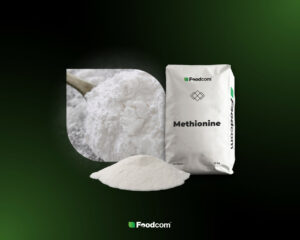- Protein amino acids are compounds included in proteins that perform important functions in the human body.
- There are 20 basic protein amino acids, of which 8 are essential amino acids, i.e. necessary to be provided to the body from outside.
- The largest industrial production of amino acids includes glutamic acid, lysine and methionine.
- Protein amino acids are used in various industrial areas: food, cosmetics, pharmaceuticals, agriculture and chemicals.
Biogenic amino acids are amino acids that occur naturally in the human body, being part of proteins. There are 20 basic protein amino acids, which are essential for the proper functioning of many of our body’s functions. They also fulfill important roles in the cosmetic industry, in the production of dietary supplements and feed additives. Why are protein amino acids so important, what biogenic amino acids do we distinguish and in what areas are they used?
What are protein amino acids?
Protein amino acids are a group of organic chemical compounds that make up proteins. According to various classifications, there are 20-23 of them, while non-protein amino acids are distinguished by more than 300.
Protein amino acids join together in a specific order (determined by the DNA of a particular organism) by means of peptide bonds, forming peptides and proteins.
The basic protein amino acids are: alanine, cysteine, aspartic and glutamic acid, phenylalanine, glycine, histidine, isoleucine, lysine, leucine, methionine, asparagine, proline, glutamine, arginine, serine, threonine, valine, tryptophan and tyrosine. In addition, selenocysteine and pyrolysine are also often mentioned, which can also form proteins, but the mechanism of their incorporation into the structure of these compounds is different.
Non-protein amino acids are, for example, GABA acid, L-DOPA, taurine or triiodothyronine.
Properties of protein amino acids
Protein amino acids occur naturally in the bodies of living organisms. They contain a basic amino group and an acidic carboxyl group. Consequently, under physiological pH conditions, they usually occur in ionic form, forming the so-called hermaphrodite ion or dipolar compound, containing ionized groups of opposite charges.
In this form, amino acids have properties typical of salts – they occur in crystalline form, have high melting points, are soluble in water and insoluble in hydrocarbons.
Protein amino acids, in terms of molecular structure, are α-amino acids having an asymmetric carbon atom with an L configuration (except for glycine) – the D configuration is found in microorganisms or plants. Biogenic amino acids have a side chain, which may be polar or non-polar, and may include: An aromatic ring, an aliphatic chain, sulfur, a hydroxyl group, and an additional amine or carboxyl group.
Division of protein amino acids
All protein amino acids can be divided in several different ways. Criteria for their division include, for example:
- side chain polarity;
- chemical nature (neutral, acidic or basic);
- the possibility of biosynthesis in the human body (endogenous or exogenous amino acids);
- the catabolic pathway and the main product of amino acid breakdown (ketogenic and glucogenic amino acids, the final products of which are ketone bodies and glucose, respectively).
The most relevant division is between endogenous and exogenous amino acids, because exogenous amino acids are the so-called essential amino acids, which the human body does not produce on its own, so they must be supplied to it in food. This is because amino acids in the body not only build proteins (i.e., thus: muscles, hormones, enzymes, neurotransmitters), but are also responsible for energy acquisition, carbohydrate and fat metabolism, cell regeneration and hormone management, ensuring the proper functioning of the body.
Exogenous amino acids include lysine, methionine, threonine, leucine, isoleucine, valine, tryptophan and phenylanaline. Relatively exogenous amino acids, that is, produced by the body, but in insufficient amounts, are arginine and histidine. Tyrosine and cysteine, on the other hand, are amino acids synthesized by the human body, but from other essential amino acids.
Uses of protein amino acids
Protein amino acids produced on an industrial scale have applications in many different areas. The best-known amino acid derivative is monosodium glutamate, used as a flavor enhancer. Many amino acids are commonly used as additives in animal feed or dietary supplements.
Food industry
Some protein amino acids are used as food additives. Of particular importance here is monosodium glutamate, which is the salt of glutamic acid. It is mainly used as a flavor and aroma enhancer, being an ingredient in: instant soups, sauces, canned foods and seasoning mixes. The flavor provided by MSG is called umami.
In addition, many essential amino acids are used as ingredients in specialty and clinical nutrition products for malnourished patients and those with special nutritional needs.
Feed and fertilizer additives
Methionine and lysine are mainly used as feed additives to increase their nutritional value. They can also be added to organic feeds. The enrichment of feed with amino acids allows the animal to better utilize the food and produce all the necessary proteins in its body. This is especially important for dairy cattle or poultry – the addition of methionine or lysine allows for increased milk and egg production and more efficient growth of animal muscle mass.
Threonine is also an important amino acid, which is given to animals as a feed additive, especially to alleviate intestinal inflammation and energy metabolism disorders. It has a positive effect on the digestive and immune systems.
Methionine is also given as a supplement to dogs to reduce the risk of kidney stones. In agriculture, methionine is also used as a non-toxic pesticide against certain caterpillars that are pests of orange crops. Lysine also can be used as a fertilizer additive to promote plant growth and improve nutritional value.
Proven, good-quality amino acids for use as feed or fertilizer additives are offered by the Foodcom store.
Drugs and dietary supplements
Protein amino acids, especially branched-chain amino acids such as leucine, valine and isoleucine, can have positive effects when taken by people who participate in sports. This is because these amino acids help build muscle mass and muscle regeneration, as well as reduce feelings of fatigue.
In addition, many amino acids are an ingredient in dietary supplements that support the nervous system, help with sleep problems and lowered mood, strengthen the immune system, and help fight cardiovascular disease or digestive troubles. In medicines, amino acids can also play a supporting role, such as leucine is used as a dispersing agent in inhalation drugs.
Tryptophan is used in drugs and dietary supplements as a treatment for depression and insomnia, as it is converted to 5-hydroxytryptophan and then to serotonin.
An interesting amino acid used in dietary supplements is taurine, which is a non-protein amino acid consisting of methionine and cysteine that occurs naturally in the human body. This amino acid has a positive effect on visual function, lowers blood pressure, protects the liver, promotes fat loss and increases energy, which is why it is used in energy drinks.
Cosmetic industry
In the cosmetics industry, protein amino acids play a significant role in the production of skin care products, especially for the face. They are often included in anti-aging creams designed to strengthen and moisturize the skin, and to soften and plump the epidermis by replenishing water deficiencies in skin cells. Threonine and proline, as well as glycine or lysine, among others, work in this way. These amino acids are precursors for the production of collagen, which gives the skin elasticity and firmness. In addition to face creams and lotions, we can also find biogenic amino acids in masks, scrubs and hair shampoos and conditioners.
Applications in scientific research and chemical industry
Some of the protein amino acids are widely used in scientific research, such as on aging or protein metabolism. From phenylalanine, amphetamine can be obtained in the laboratory.
Amino acids are furthermore crucial in biotechnology – they serve as substrates in fermentation processes carried out to produce enzymes, antibiotics and other biologically active compounds.
In the chemical industry, amino acids can be used in the synthesis of polymers, plastics and specialty chemical materials.
Biogenic amino acid market
Currently, protein amino acids are produced in various ways. They can be synthesized chemically and enzymatically, but synthesis by bacterial fermentation (e.g., by the bacteria Corynebacterium glutamicum) predominates. For example, glutamic acid and its salts are obtained by fermenting mainly soybeans.
Annual glutamate production in 2005 was 1.7 million tons, while in 2018 it was already 4.7 million tons, of which more than 75% was produced in China. Glutamic acid and its salts account for the largest portion of the biogenic amino acids produced. Also on the podium are methionine and lysine, the synthesis of which, together with glutamic acid production, accounts for 90-95% of global biogenic amino acid production. Production of amino acids in 2016 reached 7 million tons and is growing steadily – there is talk of an increase of up to 7% per year.









